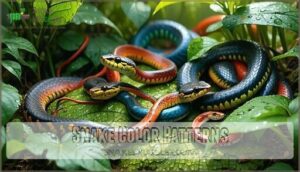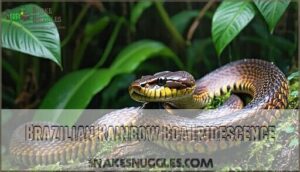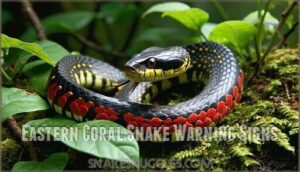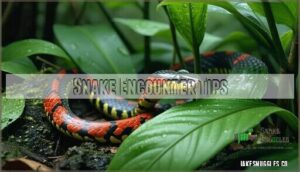This site is supported by our readers. We may earn a commission, at no cost to you, if you purchase through links.

The Kenyan Sand Boa stays under two feet with gorgeous patterns, while Corn Snakes showcase vibrant oranges and reds.
Western Hognose snakes aren’t just colorful—they’re drama queens who play dead when threatened.
Ball Pythons rarely exceed four feet and come in incredible color morphs.
The Brazilian Rainbow Boa literally shimmers like a prism in sunlight.
Asian Vine Snakes sport brilliant greens, and Eastern Coral Snakes display striking red, yellow, and black bands.
These pocket-sized beauties pack serious visual punch, but there’s more to their colors than meets the eye.
Table Of Contents
- Key Takeaways
- Small Colorful Snakes
- Snake Color Patterns
- Vibrant Snake Species
- Snake Encounter Tips
- Rare Colorful Snakes
- Frequently Asked Questions (FAQs)
- What kind of snake is multicolored?
- How do I identify a snake I found?
- What is the prettiest snake breed?
- Do colorful snakes make good pets?
- Which colorful snakes are completely harmless?
- How long do small colorful snakes live?
- What climates support the most colorful species?
- Can colorful snakes change their patterns seasonally?
- Conclusion
Key Takeaways
- You’ll find stunning small colorful snakes like the Kenyan Sand Boa, Corn Snakes, and Brazilian Rainbow Boa that pack incredible visual punch into compact bodies under four feet long.
- You can identify venomous species by looking for triangular heads, heat-sensing pits, and distinctive patterns, but remember that harmless snakes often mimic dangerous ones through bright warning colors.
- You’ll discover that snake colors aren’t just for show—they’re survival tools created by specialized cells called chromatophores and iridophores that help with camouflage, predator warnings, and prey attraction.
- You should maintain at least six feet of distance from any colorful snake you can’t identify, and if bitten, keep the wound below heart level and call emergency services immediately for proper antivenom treatment.
Small Colorful Snakes
You’ll find that small colorful snakes pack amazing patterns and bright colors into compact bodies that often measure just 2-4 feet long.
These vibrant reptiles use their striking reds, blues, greens, and yellows for camouflage, warning predators, or attracting prey in their natural habitats.
Asian Vine Snake Characteristics
You’ll instantly recognize the Asian Vine Snake by its stunning bright yellow-green body that can expand to reveal a mesmerizing checkered pattern.
Nature’s living jewel transforms before your eyes, turning from sleek emerald to dazzling geometric art.
These arboreal snakes showcase remarkable snake camouflage abilities in Southeast Asia’s tropical forests.
Here are five key characteristics of this vibrant species:
- Color variations range from vivid green to teal, providing perfect concealment among leaves
- Arboreal adaptations include a slender 5-6 foot frame built for tree navigation
- Sensory perception helps them detect tree frogs and lizards with precision
- Snake coloration shifts dramatically when threatened, displaying contrasting patterns
- Diet specialization focuses exclusively on small arboreal prey like frogs and lizards
Sri Lankan Pit Viper Habitat
You’ll find the Sri Lankan Pit Viper thriving in rainforest ecosystems and wet grasslands across the island.
This small colorful snake species adapts to altitude variations from 153 to 1,000 meters above sea level.
The snake habitat offers abundant prey and dense vegetation for camouflage. Classified as a venomous pit viper, its bite can cause severe pain and swelling.
Unfortunately, snake conservation efforts face challenges as habitat destruction threatens these remarkable reptiles.
Blue Malayan Coral Snake Diet
The Blue Malayan Coral Snake earns its "killer of killers" nickname through an extraordinary diet that sets it apart from other venomous snakes.
You’ll find this species primarily hunting other snakes, including juvenile king cobras, using highly potent neurotoxic venom for quick immobilization.
This snake belongs to the Elapidae family.
Key Dietary Features:
- Snake cannibalism – Actively hunts and consumes other venomous snake species
- Venom effects – Delivers fast-acting neurotoxins through exceptionally long venom glands
- Hunting strategies – Uses nocturnal stealth to ambush prey in dense forest environments
- Digestion process – Specialized metabolism handles high-protein snake prey efficiently
Snake Color Patterns
You’ll find that snake colors come from special cells called chromatophores that create browns, blacks, and reds, while iridophores add that shimmery rainbow effect you see on some species.
These patterns aren’t just for show – they help snakes blend into their surroundings, scare off predators, or even attract prey depending on where they live, which is a result of the surroundings.
Chromatophores and Iridophores
Snake scales contain specialized cells called chromatophores that produce brown, black, and red pigments.
You’ll also find iridophores beneath these color cells, creating that stunning iridescence you see on species like the Brazilian Rainbow Boa.
When light hits these microscopic structures, pigment interaction occurs, giving color-changing snakes their remarkable ability to shift hues and create brilliant snake colors.
Camouflage and Threat Deterrence
Snake colors serve as nature’s clever disguise and warning system.
These reptiles master the art of survival through strategic coloration that either hides them or screams "stay away!"
- Color Camouflage: Green snakes blend seamlessly into foliage while brown species disappear against forest floors
- Aposematic Signals: Brightly colored venomous snakes advertise their danger through bold reds and yellows
- Disruptive Patterns: Striped and banded designs break up body outlines, confusing predators
Environmental Adaptations
Climate influence shapes every snake’s appearance like a master painter.
You’ll notice desert species sport sandy browns while rainforest dwellers show vibrant greens.
Habitat specificity drives camouflage evolution – Arctic snakes develop lighter scales, tropical ones gain brilliant hues.
Prey adaptation matters too.
Snake diets determine coloration purpose, with predators mimicking their favorite meals’ environments for perfect snake camouflage.
Vibrant Snake Species
You’ll discover that some snakes display colors so bright they seem almost painted by nature itself.
These vibrant species use their stunning patterns and shimmering scales for everything from perfect camouflage to warning predators about their dangerous venom.
Green Tree Python Coloration
Green Tree Python coloration showcases nature’s most dramatic makeover.
These snakes’ brightly colored specimens start yellow or red as babies, then transform into brilliant emerald adults through ontogenetic coloration.
The genetic basis creates three distinct color morphs serving a camouflage purpose against rainforest foliage.
Regional variations produce beautiful snakes whose bright green bodies with white markings create stunning color contrasts that sharply stand out against tropical vegetation.
Captive breeding has increased the popularity of unique python morphs among reptile hobbyists.
Brazilian Rainbow Boa Iridescence
Looking like nature’s own disco ball, the Brazilian Rainbow Boa showcases incredible snake iridescence through specialized scale microstructure.
These beautiful snakes create stunning light refraction effects that serve as both camouflage mechanism and evolutionary advantage in their rainforest homes.
Here’s what makes these colorful snakes extraordinary:
- Microscopic ridges act like tiny prisms on each scale
- Habitat reflection helps them blend with wet, shimmering foliage
- Rainbow effects intensify dramatically after shedding cycles
- Rusty brown base colors enhance their brightly colored iridescent display
Eastern Coral Snake Warning Signs
Nature’s bright warning system works perfectly with the Eastern Coral Snake.
You’ll spot red bands touching yellow bands – that’s your danger signal.
Mimicry snakes can fool you, but remember "red touches yellow, kills a fellow."
This venomous snake packs serious venom toxicity.
Banding patterns serve as clear coral snake identification.
If bitten, first response means immediate medical help for these deadly snake bites.
Snake Encounter Tips
When you encounter colorful snakes in the wild, you’ll need to know how to stay safe while observing these beautiful creatures.
Proper identification and maintaining safe distances can mean the difference between a memorable wildlife experience and a dangerous situation.
Identifying Venomous Snakes
Spotting venomous snakes among colorful species requires careful venom identification techniques.
Look for triangular heads, heat-sensing pits, and distinctive snake fangs in species like the Blue Malaysian Coral Snake.
However, mimicry defenses complicate snake identification since harmless snakes often copy dangerous patterns.
It’s also important to understand regional venomous species for enhanced safety.
Remember that bright colors don’t always indicate venom toxicity – some colorful snakes are completely harmless despite their warning appearance.
Understanding these concepts is crucial for safe interaction with snakes, and recognizing the difference between dangerous patterns and actual venomous species can be lifesaving.
Safe Distances and Precautions
Once you’ve spotted a potentially dangerous snake, maintaining proper distance becomes your lifeline.
Stay at least six feet away from any colorful snakes you can’t identify. Most snake bite incidents happen when people try unsafe handling or get too close.
For encounter avoidance, back away slowly without sudden movements. Consider using effective snake deterrents to further protect your space.
Your safety depends on respecting these beautiful but potentially venomous creatures from afar.
First Aid and Medical Help
Quick snake bite treatment can save your life. If bitten by venomous snakes, stay calm and get medical assistance immediately.
Snake venom effects vary, but bite symptoms often include swelling and pain.
Here’s your snake first aid plan:
- Keep the wound below heart level and avoid movement
- Remove jewelry before swelling starts and clean gently
- Call emergency services for antivenom access and proper wound care. Consider using a suitable compression bandage for immobilization.
Rare Colorful Snakes
You’ll find some of the world’s most stunning snakes hiding in remote mountains and isolated islands where few people ever see them.
These rare colorful species showcase nature’s most incredible patterns and colors, from the cream and black saddles of Boelen’s Python to the bright green males of the Bornean Keeled Pit Viper.
Boelen’s Python Habitat and Diet
You’ll find Boelen’s Python exclusively in New Guinea’s mountainous regions at 5,700 feet elevation.
This rare python snake origin traces to highland forests where it hunts ground birds and small mammals.
Unlike other snake species, it’s a diurnal predator with specific snake habitats requirements.
The Boelens Python’s snake diet includes lizard consumption, making relocation efforts unsuccessful due to these precise environmental needs, which are tied to its native mountainous regions.
Bornean Keeled Pit Viper Characteristics
The Bornean Keeled Pit Viper is a standout among colorful snakes.
Its keeled scales and vibrant color morphs offer exceptional camouflage.
Here’s what makes it unique:
- Sexual Dimorphism: Females grow up to 3 feet, males only 1.5 feet.
- Snake Habitats: Found in Borneo’s tropical forests.
- Venom Composition: Potent venom aids hunting small mammals.
A true rainforest marvel!
These snakes possess specialized pit organs for detecting prey.
Side-Striped Palm Viper Prey and Habitat
When exploring montane ecosystems in Costa Rica and Panama, you’ll discover the SideStriped Palm Viper thriving in its arboreal lifestyle.
This vibrant green predator hunts rodents, birds, lizards, and frogs using potent venom.
Unlike the Eyelash Viper or Sumatran Pit Viper, it shows interesting dietary variations based on prey availability.
Its conservation status remains stable within protected cloud forests.
Frequently Asked Questions (FAQs)
What kind of snake is multicolored?
Like nature’s living rainbow, you’ll find several multicolored snakes dazzling the world.
The Eastern Coral Snake flaunts red, yellow, and black bands, while Brazilian Rainbow Boas shimmer with iridescent colors that dance across their scales.
How do I identify a snake I found?
Take clear photos of the snake’s head, body patterns, and size.
Note its location and behavior.
Compare features like color bands, head shape, and scales to field guides or snake identification apps for your region, focusing on complete concepts to ensure accurate identification.
What is the prettiest snake breed?
Beauty’s subjective, but you’ll find stunning options like the emerald Green Tree Python with white markings, iridescent Brazilian Rainbow Boa, or striking San Francisco Garter Snake with blue-green stripes.
Do colorful snakes make good pets?
Absolutely stunning colorful snakes can make fantastic pets if you’re prepared.
You’ll need proper heating, humidity, and specialized care.
Research species like corn snakes or ball pythons – they’re beginner-friendly with gorgeous patterns.
Which colorful snakes are completely harmless?
Several colorful snakes are completely harmless to humans.
You’ll find corn snakes, ringneck snakes, and Brazilian rainbow boas make excellent choices.
They’re non-venomous, docile, and their vibrant colors won’t fade in captivity, making them a great option with docile nature.
How long do small colorful snakes live?
Like telegram operators of old, you’ll find small colorful snakes typically live 10-20 years in captivity.
Ringneck snakes average 6-10 years, while corn snakes can reach 15-20 years with proper care and diet.
What climates support the most colorful species?
Tropical rainforests and humid subtropical regions support the most colorful snake species.
You’ll find vibrant greens, blues, and reds thriving in Southeast Asia, Central America, and northern South America where warmth and moisture create perfect conditions to support vibrant life.
Can colorful snakes change their patterns seasonally?
You won’t see dramatic seasonal pattern changes in colorful snakes like chameleons do.
Their vibrant colors stay consistent year-round, though some species may show slight brightness variations during breeding seasons or molting periods.
Conclusion
Haven’t these small colorful snake species names opened your eyes to nature’s incredible artistry?
You’ve discovered fifteen vibrant reptiles that prove size doesn’t limit beauty.
From the Brazilian Rainbow Boa’s prismatic shimmer to the Western Hognose’s theatrical antics, each species brings unique charm to our world.
Remember that these colorful patterns serve important purposes beyond aesthetics—they’re survival tools perfected over millions of years.
Whether you’re a budding herpetologist or simply appreciate nature’s wonders, these remarkable snakes deserve our respect and protection.
- https://nationalzoo.si.edu/animals/brazilian-rainbow-boa
- https://education.nationalgeographic.org/resource/camouflage/
- https://www.scielo.br/j/rsbmt/a/c99dnVsy8PsBGx45whDLMDf/
- https://www.floridamuseum.ufl.edu/herpetology/fl-snakes/list/indotyphlops-braminus/
- https://animals.sandiegozoo.org/animals/kingsnake














